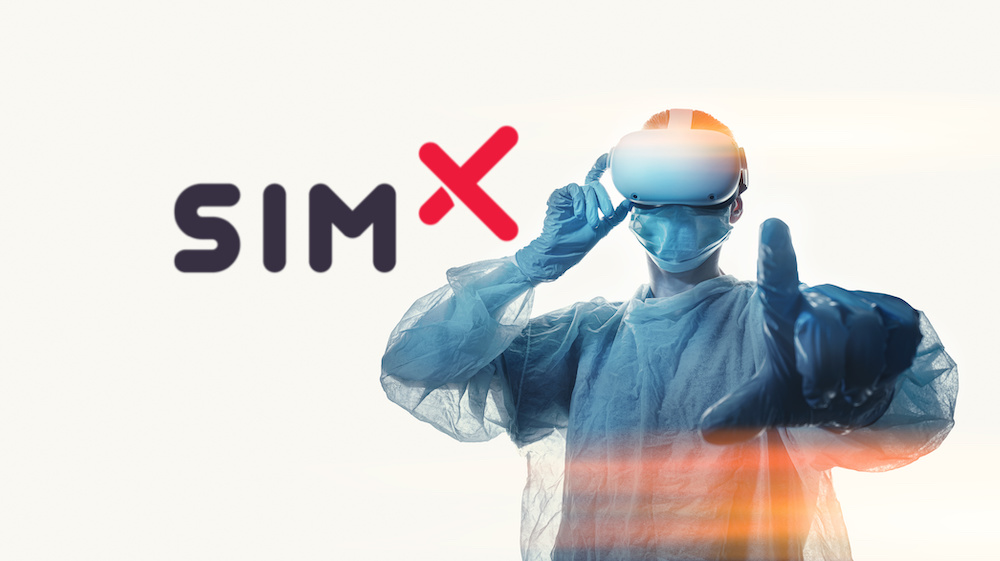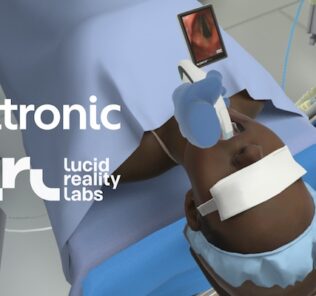How VR Simulation Training Can Reduce the Cost of Nurse Turnover
Healthcare simulation has proven to be an effective way to train nursing learners, and now the practice is becoming even more imperative across the field. For years, analysts and public health officials have warned about the growing nurse shortage in the United States, but this warning received limited attention outside of the healthcare industry. However, the impact of the COVID-19 pandemic has brought the issue into the public eye like never before. This HealthySimulation.com article shares how VR simulation training, specifically through the SimX platform, has helped to address this issue, and in-turn helped protect patient safety outcomes from being negatively impacted by such a growing shortage.
As the pandemic began to gain worldwide attention in 2020, the already strained healthcare infrastructure buckled as thousands of registered nurses became incapacitated by the virus or left their institutions due to burnout. As a result, the average turnover rate for RNs in 2020 spiked to a seven-year high of 18.6%. (1) The picture grows grimmer when data from 2021 indicates that 22% of nurses are considering leaving their current position. (1)
This high rate of nurse turnover has exacted a substantial cost on healthcare institutions, patients, and nurses themselves. While structural changes are needed to address the root cause of nursing turnover rates, a more cost-effective paradigm for training new nurses may help offset the financial burden faced by hospitals and clinics. The inclusion of virtual reality (VR) simulations into training programs may help reduce the cost of hiring new nurses while equipping these recruits with the tools and confidence to provide the best patient care.
Sponsored Content:
How Much Does Nurse Turnover Cost Health Organizations?
While the true cost of nurse turnover varies based on institution and locale, data from the annual 2021 NSI National Health Care Retention and RN Staffing Report shows that the average cost of turnover was over $40,000 for bedside RNs. (1) For the average hospital, RN turnover costs just over $5 million. However, even a 1% change in nurse turnover can save or cost nearly $271,000, making retention a pressing financial matter for healthcare systems. (1)
The cost of nursing turnover is, unfortunately, not just financial. Patient outcomes are directly tied to adequate staffing levels and healthcare retention. As reported by a 2011 paper in the New England Journal of Medicine, understaffing of RNs is associated with increased patient mortality. (2) The study found that patients’ risk of death increased by 2% for every below-target shift. Chillingly, this number jumps to a 4% increased risk of death per shift with high turnover. Considering that 62.5% of hospitals have a vacancy rate for RNs over 7.5%, institutions must maintain adequate staffing by retaining experienced nurses and effectively training new nurses. (1)
How Much Does It Cost to Train a New Nurse?
Sponsored Content:
A 2015 systematic review published in the Journal for Nurses in Professional Development estimated that replacing a newly licensed RN can cost anywhere between $62,000 and-67,000 dollars. (3) In some cases, this cost may be dramatically offset by implementing better nursing orientation and training programs.
Adoption of a more effective orientation program cut the rate of new graduate nurse attrition from 29.5% to 12.3% at the Children’s Hospital in Chicago. (4) Likewise, on-the-job training and orientation changes caused a drop from 50% to 13% in two years at the Methodist Hospital of Houston, yielding a return on investment of nearly 885%. (4)
Medical simulations are a long-recognized staple for nursing learners and fresh RN graduates as they are onboarded into hospital life. (5) Letting new nurses practice on simulated patients builds their skills and confidence without risking harm to a real human patient. (5) Research indicates that nursing learners develop a more thorough understanding of medical principles through simulation-based learning. (6)
However, not all simulations are equally effective. For example, while simulators of all levels of realism can teach critical skills, nursing learners preferred those with higher fidelity. (7,8) In addition, the cost of training a new nurse adds up; institutions need to pay for travel expenses, hourly wages, overtime pay for nurses who have to cover shifts, and the fees for the healthcare simulation. (9)
The latter can rack up costs since higher-fidelity simulators that deliver more nuanced training cost substantially more to maintain. (9) Institutions need a training method that can reduce the cost of nurse turnover without compromising the quality of training. Thus, VR medical simulation training may be the ideal solution to train new nurses while reducing the cost of nurse turnover.
How Can VR Reduce Nurse Training Costs?
Medical VR simulations offer unparalleled realism; scenarios that would be impossible to recreate in real-world settings can be safely run on VR. This bodes well for disaster training, such as hospital evacuations, natural disasters, and active shooter events. (10, 11) Not only do VR simulations make certain kinds of training more feasible, but they also make training more affordable overall.
VR training reduces costs by cutting out the need for travel expenses and overtime, as only a small space is needed for VR simulations. (9, 11) Although some VR simulations and technology require an upfront investment, an individual headset and training license can train multiple people in a range of different scenarios. One study showed that even when VR training is initially more expensive than healthcare simulations, after three years, each VR session costs nearly a third of traditional simulation training. (9)
In addition, VR simulations are much more engaging to users than other forms of simulation. (12) This may be due to the feeling of presence felt during immersive VR experiences. Since learners tend to value training with high-fidelity simulations over low-fidelity ones, VR training may give new nurses a greater perceived value of nursing simulation training, which builds positive attitudes towards learning experiences. (8, 12)
SimX VR for Nursing Training
SimX is a fully-featured VR platform for medical simulation training. This high-fidelity VR software package comes equipped with over 100 scenarios and simulated patients that the instructor can modify for variety and specific teaching points. In addition, SimX can even customize scenarios for healthcare institutions at a reasonable cost.
Since SimX is cloud-based, the solution can be run on any hands-free consumer-grade VR headset with an internet connection. This connectivity allows trainees and trainers from across the world to connect for learning experiences in the same virtual space as if they were in the room together (a feature unique to the SimX platform). Moreover, SimX automatically scores key training metrics and can be recorded for later review, meaning trainers can focus on their learners’ experience holistically at the moment instead of fixating on scoring. Meanwhile, the skills gleaned by trainees help reduce their rate of medical errors.
Finally, SimX has partnered with the global publisher Elsevier to develop our exclusive Simulation Learning System for RN with Virtual Reality (SLS with VR) program. This initiative puts VR training in the hands of nursing learners and new nurses to provide quality training experiences during and after the COVID-19 pandemic. SLS with VR through the SimX platform has several affordable pricing options that help institutions reduce the cost of nurse turnover without reducing the quality of care for patients. Visit the SimX website to sign up for a free trial to see what the platform can do for each respective institution and healthcare simulation program.
More About SimX
SimX brings virtual and augmented reality to medical simulation training. The company’s product is the first comprehensive professional-grade VR medical simulation system and is used to train physicians, nurses, and other allied health professionals. The SimX platform allows medical teams to replace expensive mannequins with incredibly flexible simulated patients, backed by a robust physiology engine.
Retention & RN Staffing Report. 2021.
2. Needleman J, Buerhaus P, Pankratz VS, Leibson CL, Stevens SR, Harris M. Nurse staffing and inpatient hospital mortality. N Engl J Med. 2011;364(11):1037-1045.
3. Goss CR. Systematic review building a preceptor support system. J Nurses Prof Dev. 2015;31(1):E7-14.
4. K vanWyngeeren TS. Increasing New Graduate Nurse Retention from a Student Nurse Perspective. RN Journal. 2016.
5. Durham CF, Alden KR. Enhancing Patient Safety in Nursing Education Through Patient Simulation. In: Hughes RG, ed. Patient Safety and Quality: An Evidence-Based Handbook for Nurses. Rockville (MD)2008.
6. Rajaguru V, Park J. Contemporary Integrative Review in Simulation-Based Learning in Nursing. Int J Environ Res Public Health. 2021;18(2).
7. Kim J, Park JH, Shin S. Effectiveness of simulation-based nursing education depending on fidelity: a meta-analysis. BMC Med Educ. 2016;16:152.
8. Basak T, Unver V, Moss J, Watts P, Gaioso V. Beginning and advanced students' perceptions of the use of low- and high-fidelity mannequins in nursing simulation. Nurse Educ Today. 2016;36:37-43.
9. Senvisky JM, McKenna RT, Okuda Y. Financing And Funding A Simulation Center. In: StatPearls. Treasure Island (FL)2021.
10. Duan YY, Zhang JY, Xie M, Feng XB, Xu S, Ye ZW. Application of Virtual Reality Technology in Disaster Medicine. Curr Med Sci. 2019;39(5):690-694.
11. Farra SL, Gneuhs M, Hodgson E, et al. Comparative Cost of Virtual Reality Training and Live Exercises for Training Hospital Workers for Evacuation. Comput Inform Nurs. 2019;37(9):446-454.
12. Pottle J. Virtual reality and the transformation of medical education. Future Healthc J. 2019;6(3):181-185.
Sponsored Content:



















